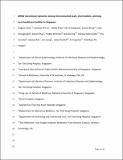MRSA transmission dynamics among interconnected acute, intermediate-term, and long-term healthcare facilities in Singapore
View/
Date
15/05/2017Author
Funder
Grant ID
097831/z/11/z
Keywords
Metadata
Show full item recordAbstract
Background: Methicillin-resistant Staphylococcus aureus (MRSA) is the most common healthcare-associated multidrug-resistant organism. Despite the interconnectedness between acute care hospitals (ACHs) and intermediate- and long-term care facilities (ILTCFs), the transmission dynamics of MRSA between healthcare settings is not well understood. Methods: We conducted a cross-sectional study in a network comprising an ACH and 5 closely affiliated ILTCFs in Singapore. A total of 1700 inpatients were screened for MRSA over a 6-week period in 2014. MRSA isolates underwent whole-genome sequencing, with a pairwise single-nucleotide polymorphism (Hamming distance) cutoff of 60 core genome single-nucleotide polymorphisms used to define recent transmission clusters (clades) for the 3 major clones. Results: MRSA prevalence was significantly higher in intermediate-term (29.9%) and long-term (20.4%) care facilities than in the ACH (11.8%) (P < .001). The predominant clones were sequence type [ST] 22 (n = 183; 47.8%), ST45 (n = 129; 33.7%), and ST239 (n = 26; 6.8%), with greater diversity of STs in ILTCFs relative to the ACH. A large proportion of the clades in ST22 (14 of 21 clades; 67%) and ST45 (7 of 13; 54%) included inpatients from the ACH and ILTCFs. The most frequent source of the interfacility transmissions was the ACH (n = 28 transmission events; 36.4%). Conclusions: MRSA transmission dynamics between the ACH and ILTCFs were complex. The greater diversity of STs in ILTCFs suggests that the ecosystem in such settings might be more conducive for intrafacility transmission events. ST22 and ST45 have successfully established themselves in ILTCFs. The importance of interconnected infection prevention and control measures and strategies cannot be overemphasized.
Citation
Chow , A , Lim , V W , Khan , A , Pettigrew , K , Lye , D C B , Kanagasabai , K , Phua , K , Krishnan , P , Ang , B , Marimuthu , K , Hon , P-Y , Koh , J , Leong , I , Parkhill , J , Hsu , L-Y & Holden , M T G 2017 , ' MRSA transmission dynamics among interconnected acute, intermediate-term, and long-term healthcare facilities in Singapore ' , Clinical Infectious Diseases , vol. 64 , no. suppl_2 , pp. S76-S81 . https://doi.org/10.1093/cid/cix072
Publication
Clinical Infectious Diseases
Status
Peer reviewed
ISSN
1058-4838Type
Journal article
Description
This work was supported by the Ministry of Health, Singapore (Communicable Diseases–Public Health Research Grant), the Wellcome Trust (Institutional Strategic Support Fund award [grant 097831/Z/11/Z] to the University of St Andrews Bioinformatics Unit), and the Scottish Infection Research Network and Chief Scientist Office (Scottish Healthcare Associated Infection Prevention Institute consortium funding [Chief Scientist Office reference SIRN10] to K. P. and M. T. G. H.).Collections
Items in the St Andrews Research Repository are protected by copyright, with all rights reserved, unless otherwise indicated.

